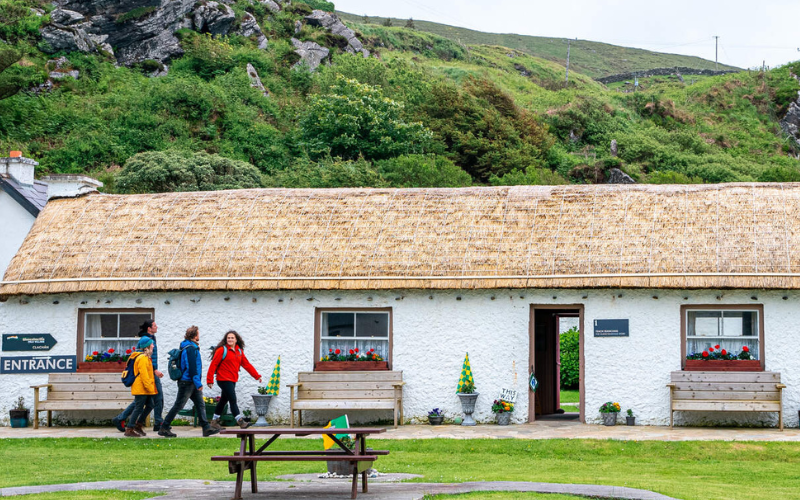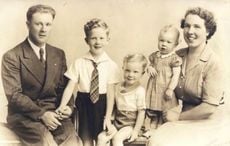I love the sound of a saxophone most of all.
It should be called the sexophone really because the glittering figure of it has all the curves in all the right places, and it has a voice as sultry as it gets. The saxophone is feminine but it has a pagan throat.
I have lived my life in two Irelands. One was Ireland before the saxophone arrived. The other has been Ireland since then.
I was 12 when I heard it first. The last of the traveling shows made a stop in the Hibernian Hall in our parish and I was allowed to cycle there by myself.
The show was called Clarrie Hayden's Show. It was long past the heyday of the fit-up companies which had been so popular in Ireland before that, but Haydens were still on the road. I don't remember them calling afterwards so maybe this was their swansong season.
But anyway, I was 12 and I was there. I was up in one of the front rows and I had the bicycle lamp in my tweed overcoat pocket in case it would be thieved off the bike during the show.
And that was the night when I first saw and heard the sound of the saxophone.
I swear I would have loved the tone and timber of the instrument just as much if it had been played by the big fat dark man who appeared as the murderer in the performance of "The Murder in the Red Barn" immediately afterwards and put the fear of God into us all. But my enjoyment was certainly enhanced by the sight of the musician.
She was the image of a young Dolly Parton, and she was wearing the shortest skirt ever seen in the parish. It glittered like a thousand stars as she opened her performance by dancing a hornpipe, and thereby revealed to all and sundry that she was wearing glittering knickers underneath.
I expected the parish priest to burst open the back door and excommunicate us all on the spot. But he did not spoil the show.
And after she danced to thunderous applause she picked up the saxophone from backstage and began to play.
Let's backtrack for a moment here. The only music and musical instruments I'd seen until then were those associated with Irish music.
Irish music was the only music we heard. It was a central part of the old culture. It was played on fiddles and flutes and tin whistles and accordions and the occasional concertina.
We had no uileann pipers in our area, and the guitar and the banjo family were quite unknown. So the choir of instruments I mention were the custodians of the culture.
They were, in some fashion, somehow Catholic instruments, nearly as Catholic a symbol as the chapel. It's a connection I don't have the word power to capture totally, but I hope ye get the gist of it.
So the glittering lady with the glittering knickers and the glittering saxophone began to play. I will never forget the tune she played either. It was a rocky jazzy thing called "Yacketysax" that became a major hit afterwards and that you can still hear today.
It exploded out over the Hibernian Hall like a golden brassy gale of sound, totally different to anything the young ones like me had ever heard before. The feet began to tap on the rickety enough wooden floor until the place was genuinely rocking. It was something else.
I have to backtrack for a second again. This was the postwar era when the awesome power of the Catholic Church was totally opposed to the corrupting consequences of listening to foreign music.
The church called it jazz and it led, they said, to occasions of major sin. There were orchestras playing such music in the commercial ballrooms, Glen Miller type bands, and it is now known that part of the reason for the church's fierce opposition was due to the commercial fact that the priests needed to maintain the crowds at the ceilis in their parochial halls.
Anyway, after the glittering lady played we had a barnstorming performance of "The Murder in the Red Barn." The young lady, not wearing glitter any more, but a gray gown and a tragic face, became the tragic Maria Martin.
The fat man who seemed to be the boss of the outfit roared out, "An eye for and eye! A tooth for a tooth!
Blood for blood!" and murdered her up on the stage before us all, before the curtains closed the foul sight away from us all and thanks be to God for that.
I cycled home among my neighbors after what was deemed to have been a great night by all. The saxophone kept ringing in my head.
And do ye know that it was only five or six years later that the saxophone stole away the heart and dancing feet of the whole country and nearly totally killed the Irish music. By the time I was 17 the showband scene was exploding everywhere throughout the land.
And the central sound of the showbands was provided by saxophones supported by trombones and other brass elements together with the first gleaming guitars. An odd accordion maybe to back C&W favorites, but never a fiddle or a flute.
And glittering female vocalists -- and glittering males too -- kicking up their well choreographed heels on the floodlit stages of hundreds of new ballrooms everywhere.
The ceili bands disappeared almost totally. Their music almost died too and would have were it not for the timely foundation of Comhaltas Ceoltoiri Eireann, the body that has been successfully promoting it ever since.
And in another 20 years the hundreds of showbands melted away like snow off the ditches and the discos arrived.
I was in Ennis this evening late. On a street corner two buskers were working the thin enough footfall.
The thin bearded one on the sax stopped me in my tracks with "Yacketysax," and the other one strummed a battered guitar.
I happily turned all my loose change into coinfetti for the hat and came home to write this.




Comments